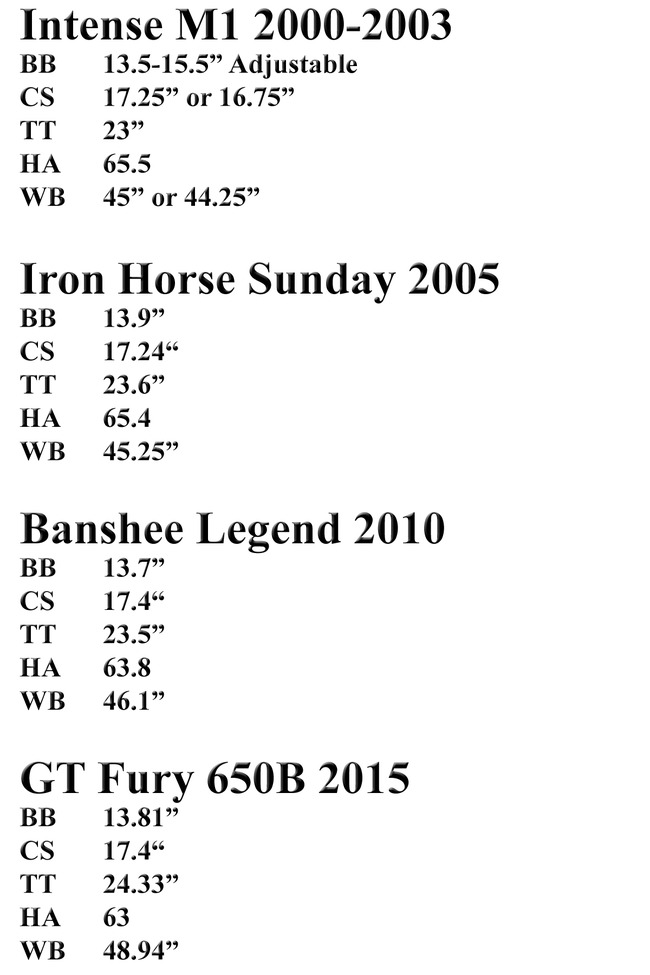Downill Mountain Bike Geometry Creates A Trickle Down Effect
The last 15 years have provided some major breakthroughs in mountain biking. Wether it is brakes, rim material, suspension designs, suspension systems from dampers to chassis refinements almost all the major findings come from the Downhill segment. This is where athletes push themselves and the equipment to the outer limits reaching insane speeds over rough terrain and just pounding the piss out of the products. Everything trickles down from Downhill and spreads into the other segments of the sport including Enduro , AM and even XC. This includes bike geometry which has becomes longer and lower over time.
Take a look at the chart above these are all medium bikes. Over the years the TT and WB has become longer while the BB has become lower. The biggest difference is probably in the HT angles they have slackened a fair amount and Mondraker even had a production bike in the 62 neighborhood a few years back! These traits will help add stability, improve cornering and make steep sections more manageable.Many of todays trail bikes in the 6" segment have been following the same trend.
There are a few Enduro bikes out with 65 degree HA and boasting wheelbases in the 48" range. That is slack and long by any stretch. These 160mm bikes by virtue of geometry alone are a better handling bike than many dedicated DH bikes were from a decade ago. They have caught up to the older generation of downhill bikes in stability but the new dedicated gravity bikes are even longer and lower still with the added travel and braking power afforded by more travel.
Having trail bikes become lower, slacker and longer will allow riders to tackle terrain that used to be downhill specific. This can have both good or bad consequences in the long run. Will trails once ridden by a few small handfuls become the trails ridden by the majority some of which may not have the skills to be riding on in the first place? Maybe this will show new trails to riders that are responsible and will help to maintain the system and keep its location a closely guarded secret?
There are some trail bikes out now like the GT Sanction or the Guerrilla Gravity Megatrail that are much closer to a Downhill Bike in terms of geometry. These two bikes are at the far end of the trail bike spectrum. They are trail bikes for Downhillners not trail bikes for XC riders.
As downhill teams spend the money finalizing suspension designs, platforms,and bike geometry the rest of the Mountain Biking world waits in anticipation to see what the fastest on the planet have learned. These findings will typically be implemented into production Downhill bikes and eventually some of these changes will find their way onto the Enduro bikes or even the XC race bikes lines.
Mondraker Bikes is using a geometry they call Forward Geometry. Read a bit below about it...
"Mondraker is relaunching a new geometry concept that offers clear advantages in any category compared with a traditional geometry as all its benefits are focused on improving control, handling and confidence.
Forward Geometry is evolving, in combination with the new 27´5” wheel in All Mountain and Enduro, and 29er in Trail and Marathon, to provide a more democratic compromise and greater customisation options for all users. The basis of the FG concept remains unchanged; the geometry has longer top tubes that are completely balanced with shorter stems. The additional top tube length is the same as the stem loses, so as a result all contact points between the rider and the bike remain in the same position as in a traditional geometry; the only difference lies in the front wheel axle that is moved forward. There is no change in the rest of the geometry.
- Security in steep areas
The front axle is more advanced that in any other geometry making almost impossible to go over the bar in steep sections, it feels more secure and confident due to the slacker angle perception.
- Confidence at high speed
The longer wheelbase makes the bike much more stable over any terrain.
- Direct steering
The really short 10 mm, 30 mm or 50 mm stems mean much less handlebar movement to get the same front wheel angle, thus improving steering precision and making the bike extremely reactive.
- Uphill precision
The front wheel keeps the contact on the ground avoiding wheelies due the longer front-center length.
- Stability on rough sections
The FG defends a new weight balance between front and rear wheel making possible to load the front wheel a lot more than with a classic geometry. This possibility change your handling giving better grip in cornering and improving the control.
Forward Geometry offers new sensations in any category from Marathon to Downhill, as after a short period of adaptation to the handling of the bike overall control improves more than you had imagined. The new geometry makes your riding more stable, reactive and confident, giving you the chance to go faster"
Dave Weagle





 Permalink
Permalink 
